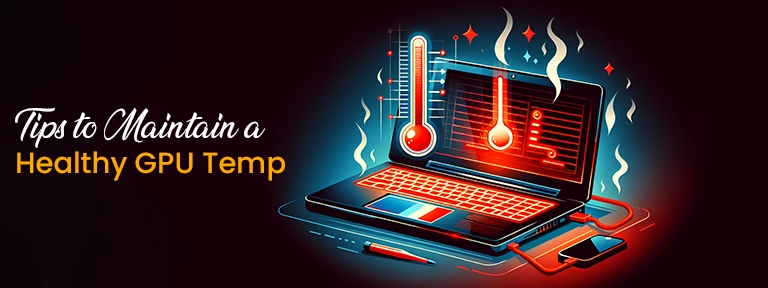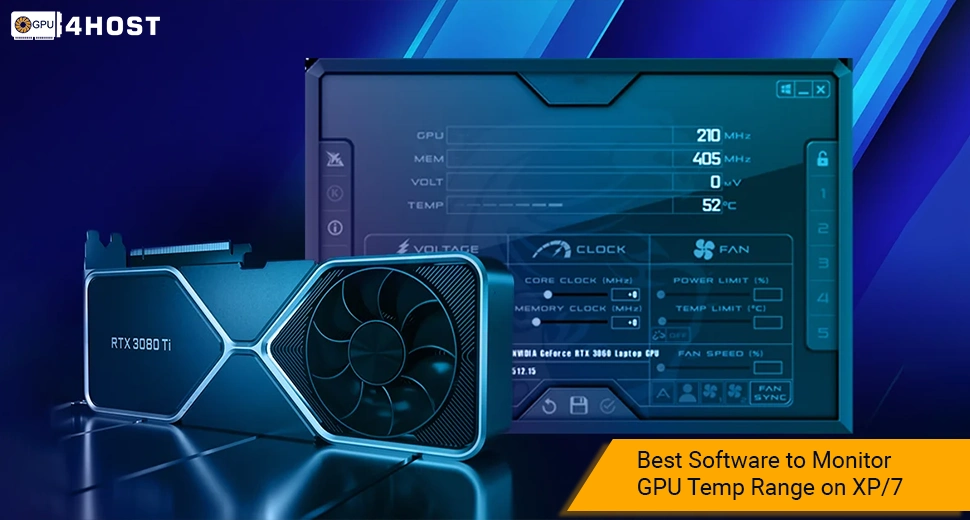Best Software to Monitor GPU Temp Range on XP/7
Tracking your GPU temp range is one of the most important aspects to make sure that your graphics card works in a completely healthy GPU temp and prevents excess heating issues. If you are utilizing an older OS such as Windows 7 or Windows XP, you just want trustworthy software to effortlessly monitor your GPU temp precisely. In this we will cover information about the best tools for tracking GPU temp range, allowing you to maintain a safe GPU temp at the time of playing games, working, or utilizing a GPU hosting service.
Why Monitoring GPU Temp Range is Necessary
Even if you are a content creator, gamer, or utilizing a GPU dedicated server, it is crucial to keep an eye on your GPU temp range. Overheating can result in performance throttling, system crashes, and also permanent or long-term hardware damage. A normal GPU temp guarantees long-term and top-notch performance.
What is the Average GPU Temp?
The average GPU temp variations completely rely on the GPU model, workload, and cooling system. Here’s a complete breakdown of temperature:
- Idle: 30°C to 45°C
- Normal GPU Temp under load: Ranges from 60°C to 75°C
- Average GPU Temp while gaming: 65°C to 85°C
- Dangerous Levels: More than 90°C
Always make sure to keep your GPU temp range under all these specified values to get a healthy GPU Temp and expand its life cycle.
Best Software to Monitor GPU Temp Range on Windows XP/7

1. GPU-Z
GPU-Z is a fully lightweight utility engineered especially to offer detailed information related to your GPU, consisting of real-time temperature tracking. It effortlessly supports both Windows 7 and Windows XP, which makes it a perfect choice for all former systems.
Key Characteristics:
- Showcases real-time GPU Temp Range
- Displays memory usage, fan speed, and clock speeds
- Supports numerous GPUs at the same time, making it a perfect choice for GPU hosting configurations
- No installation needed (portable version accessible)
2. HWMonitor
HWMonitor is a well-known and helpful hardware monitoring tool, offering precise GPU temp values along with voltages, CPU temperature, and fan speeds.
Key Characteristics:
- Shows both normal GPU temp and average GPU temp
- Flawlessly supports a variety of sensors, providing a complete hardware brief
- Record temperature data, advantageous for resolving GPU hosting server issues
- Completely lightweight and user-friendly
3. MSI Afterburner
It is generally utilized in the case of overclocking; MSI Afterburner also consists of a robust GPU temp monitoring quality, helping users to easily track real-time GPU temp range.
Key Characteristics:
- Personalize fan profiles to have a healthy GPU Temp
- On-screen display (OSD) for monitoring GPU Temp Range in real-time while playing games
- Supports both Windows XP and Windows 7 and different GPU brands
- Ideal for tracking average GPU temp at the time of gaming
4. SpeedFan
SpeedFan is a flexible tool that simply tracks CPU temp, fan speeds, and GPU Temp, helping all users to easily regulate cooling components productively.
Key Characteristics:
- Tracks safe GPU temp range
- Scales fan speeds powerfully to have a normal GPU temp
- Record GPU Temp Range for the purpose of analysis
- Works properly on the previous generation Windows versions like 7 and XP
5. Open Hardware Monitor
Open Hardware Monitor is an open-source and freely available tool that offers complete and valuable insights into your hardware performance, consisting of GPU Temp Range.
Key Characteristics:
- Real-time monitoring of average GPU temp
- Flawlessly supports Windows XP and Windows 7, making it the best option for older setups
- Shows safe GPU temp edge
- Perfect for GPU dedicated server settings
6. AIDA64 Extreme
AIDA64 Extreme is an enterprise-level software providing thorough hardware diagnostics and GPU Temp Range monitoring. It’s one of the best options for modern users and experts utilizing GPU hosting services.
Key Characteristics:
- Comprehensive GPU temp details
- Benchmarking tools to check average GPU temp at the time of gaming
- Personalizes warnings for high GPU Temp Range
- Works well with Windows XP and Windows 7
Tips to Maintain a Healthy GPU Temp

Maintaining a safe GPU temp is essential for both performance and stability. Follow all these below-mentioned tips to always keep your GPU Temp Range under inspection:
- Guarantee proper ventilation: Always keep your PC case fully ventilated to have a normal GPU temp.
- Clean your GPU periodically: Dust buildup can also raise GPU Temp; so try to clean the heatsink and fans at particular intervals.
- Implement fresh thermal paste: Previous thermal paste can also degrade, resulting in an increased GPU Temp Range.
- Utilize software-controlled fan profiles: Various tools such as MSI Afterburner let all custom fan curves easily manage average GPU temp.
- Prevent overclocking (if avoidable): Overclocking raises GPU Temp, so try to balance performance along with safe GPU temp.
- Check temps during gaming: If your average GPU temp at the time of playing games increases from 85°C, consider more improved cooling solutions.
Why GPU Temp Monitoring Crucial for a GPU Dedicated Server & GPU Hosting
For all organizations and experts utilizing a GPU dedicated server or GPU hosting, tracking the GPU temp range is a lot more necessary. Heavy workloads can increase temperatures, usually to dangerous levels, leading to performance loss or system crashes. Utilizing monitoring software guarantees:
- Balanced performance for artificial intelligence, modern gaming, or rendering tasks
- Avoid thermal throttling by simply maintaining a healthy GPU Temp
- Boosted hardware life cycle, decreasing the requirement for regular replacements
Conclusion
Keeping all records of your GPU temp range is crucial for having system stability and guaranteeing extended GPU health. Even if you’re playing games, doing heavy tasks, or utilizing a GPU dedicated server, various tools such as GPU-Z, MSI Afterburner, and HWMonitor help keep a safe GPU temp. By checking your average GPU temp and obeying all mentioned practices, you can easily maintain a normal GPU temp and get the ideal performance from your hardware.
By utilizing the ideal software, especially for Windows XP/7, you can productively handle your GPU temp range and avoid overheating problems, ensuring high performance in all situations, consisting of GPU hosting settings. Start monitoring your GPU temp now to have a healthy GPU temp and prevent long-term harm to your hardware.


